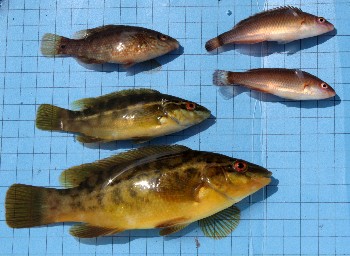Knowledge remains inadequate to justify a network of voluntary protected areas for wild wrasse within the Wester Ross MPA
Posted: Thursday 25 May, 2017 @ 01:52:52

A meeting took place in Ullapool on the 4th May 2017 to consider a proposal to set up a network of voluntary protection areas for wild wrasse, around the coastlines of properties belonging to the Scottish Wildlife Trust (Beinn More Coigach), the National Trust for Scotland (Inverewe Estate), the RSPB (Priest Island) and the Isle Martin Trust.
In the past three years, the fishery for wild wrasse within the area has provided a source of cleaner fish for local salmon farming company, Wester Ross Fisheries, for the control of parasitic sea lice on farmed salmon.
Reported lice levels on salmon farms within the area have been very much lower than in previous years up to 2013. Heavily sea louse infested sea trout were not seen within the Two Brooms area by WRFT sampling teams in 2015 and 2016 in contrast to earlier years.
The aim of the proposed network, in line with the precautionary approach, was to ensure that wild wrasse populations in some parts of the Wester Ross MPA would be fully protected thereby providing ‘safe havens’ where wrasse would be able to breed without disturbance and from where juvenile wrasse could spread out into other areas to support a sustainable wrasse fishery in surrounding areas.
A similar ‘common sense’ network of small no-take protection areas in New Zealand has benefited many fish species and nearby fisheries. For a review, please see:
http://cmscoms.com/wp-content/uploads/2014/05/Ballantine-50-years-on.pdf
The meeting in Ullapool was attended by representatives of the salmon farming industry, representatives of the Scottish Government and agencies Marine Scotland and Scottish Natural Heritage; from two of the NGOs with properties adjoining the Wester Ross MPA (a 3rd NGO rep’s video conferencing connection failed) and by Peter Cunningham.
Representatives of the salmon farming industry insisted that there was no need for the proposed network of protection areas. However because of an inadequate system for data collection, data compilation and analyses, and therefore inadequate knowledge of wrasse stocks; Marine Scotland scientists were unable to provide evidence as to whether populations of the five wrasse species (Ballan wrasse, Goldsinny wrasse, Corkwing wrasse, Cuckoo wrasse and Rock Cook) within the area were currently being fished for sustainably or not.
The following action points were agreed:
• There is a need to look in more detail at industry-wide catches of wrasse. SSPO and the Scottish Government will take this forward with Marine Scotland scientists, and Marine Scotland compliance.
• Further discussions between SG, Marine Scotland Science and the SSPO will take place regarding other measures that are needed to improve knowledge of wrasse fisheries and management requirements.
The final report from the meeting can be found on the downloads page of this website or by clicking here.